#smooth cordgrass
Explore tagged Tumblr posts
Text
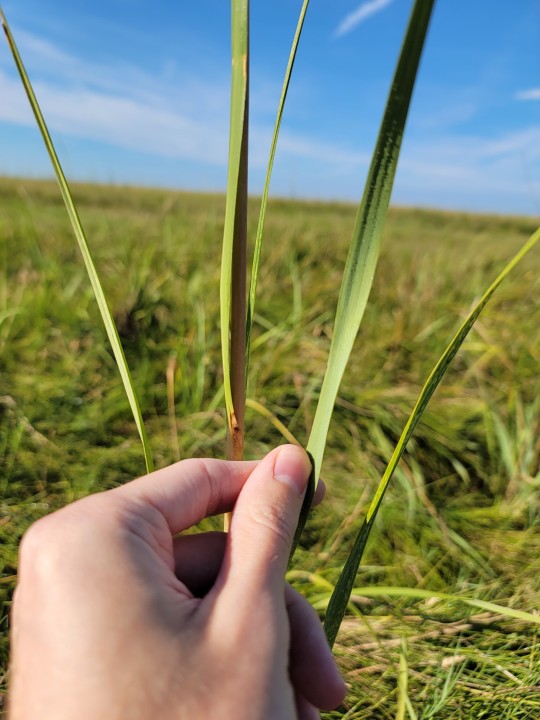
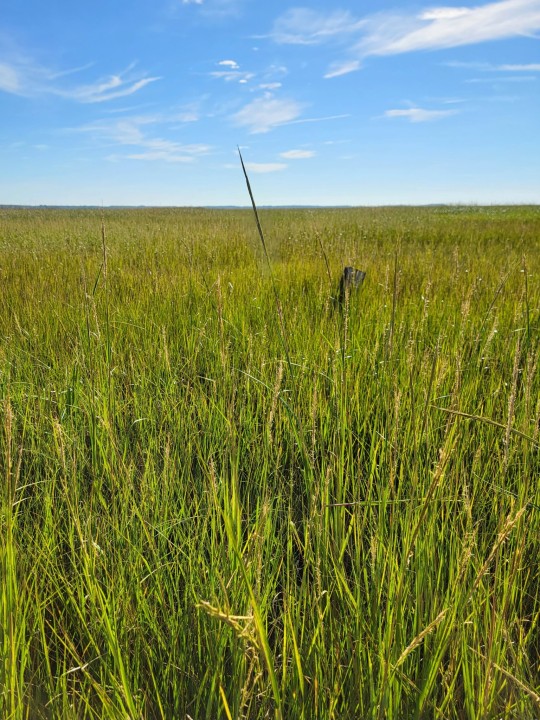
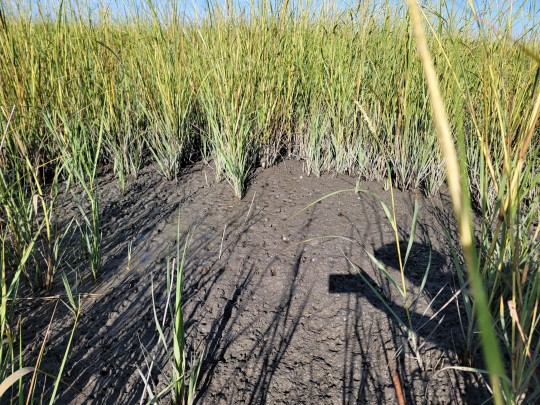
Spartina Alterniflora (aka Sporobolus Alterniflorus) - Smooth Cordgrass
Smooth Cordgrass is many things: a signifier of salinity, an extremophile, a creator of habitat, and a peat builder. This lovely species typically colonizes the low marshes of heavily salinited areas near the ocean where other plants cannot. It is endemic to the Atlantic coast of both North and South America, forming the backbone of most brackish ecosystems. While it may appear to create a monoculture within its habitat niche, Cordgrass actually does such an important job in building marsh.
As sediments collect from rising tides the colonal roots of this plant trap nutrients to accure peat and in turn provides a lot of habitat for mussels, fiddlercrabs, nesting birds, and other prey species. The process of building this peat is called marsh accretion, its what allows marshes to build elevation and migrate in the face of sea level rise. Similar to Mangroves, Cordgrass can monopolize saline habitats due to its ability to survive tidal conditions and secret salt from its leaves (zoom in on the leaf with my finger to see salt crystals collecting).
Salt grass can grow up to six feet tall and typically spreads colonally or via seed. As sea levels rise many existing salt marshes are dying, however, cordgrass individually is rather resilient, as it is one of the few species which can cope under increasing exposure to salinity. In Philadelphia we see this species slowly creep up the waterways as salinity increases up the Delaware River. Spartina Alterniflora is very famously invasive in other areas of the world however here where there is biological control we see heavy losses to existing ecosystems (especially in the Chesapeake bay) as stresses from climate catastrophe increase.
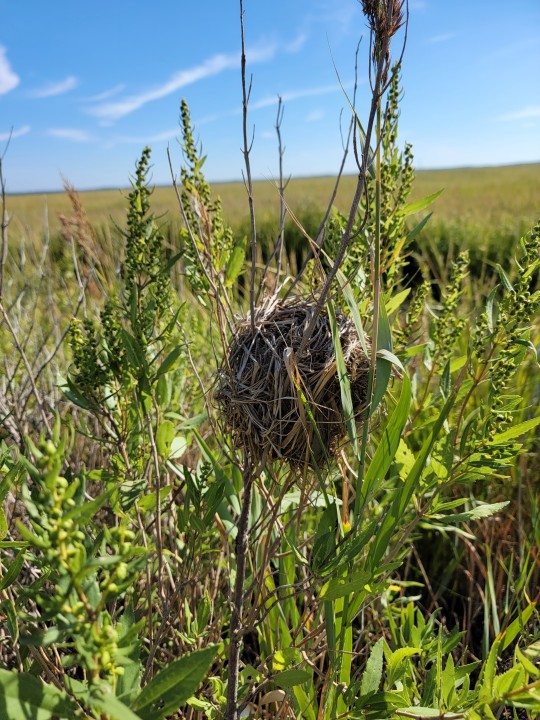
I have a lot of love for this species and it's ability to carve out a bountiful ecosystem in what is considered a desert to almost all other lifeforms (image above: Nest made from cordgrass).
#native plants#brackish ecosystem#Delaware bay#spartina alterniflora#smooth cordgrass#salt marsh#brackish ecosystems of the american atlantic#i believe spartina is an extremely distinct genus which is why i don't use sporobus personally#but that's a very Mid-Atlantic opinion apparently#which the science is still debating a bit on#plant profiles
6 notes
·
View notes
Text
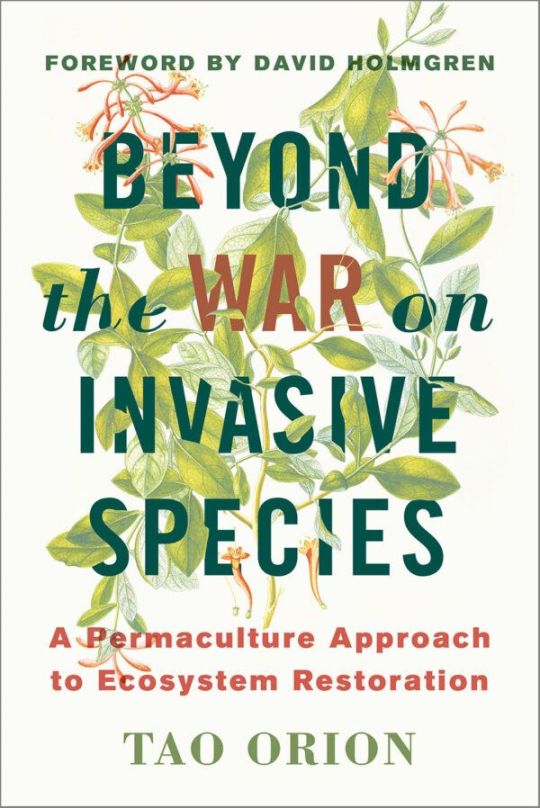
Beyond the War on Invasive Species: A Permaculture Approach to Ecosystem Restoration
By Tao Orion
Invasive species are everywhere, from forests and prairies to mountaintops and river mouths. Their rampant nature and sheer numbers appear to overtake fragile native species and forever change the ecosystems that they depend on.
Concerns that invasive species represent significant threats to global biodiversity and ecological integrity permeate conversations from schoolrooms to board rooms, and concerned citizens grapple with how to rapidly and efficiently manage their populations. These worries have culminated in an ongoing “war on invasive species,” where the arsenal is stocked with bulldozers, chainsaws, and herbicides put to the task of their immediate eradication. In Hawaii, mangrove trees (Avicennia spp.) are sprayed with glyphosate and left to decompose on the sandy shorelines where they grow, and in Washington, helicopters apply the herbicide Imazapyr to smooth cordgrass (Spartina alterniflora) growing in estuaries.
The “war on invasive species” is in full swing, but given the scope of such potentially dangerous and ecologically degrading eradication practices, it is necessary to question the very nature of the battle.
Beyond the War on Invasive Species offers a much-needed alternative perspective on invasive species and the best practices for their management based on a holistic, permaculture-inspired framework.
Utilizing the latest research and thinking on the changing nature of ecological systems, Beyond the War on Invasive Species closely examines the factors that are largely missing from the common conceptions of invasive species, including how the colliding effects of climate change, habitat destruction, and changes in land use and management contribute to their proliferation.
There is more to the story of invasive species than is commonly conceived, and Beyond the War on Invasive Species offers ways of understanding their presence and ecosystem effects in order to make more ecologically responsible choices in land restoration and biodiversity conservation that address the root of the invasion phenomenon.
The choices we make on a daily basis―the ways we procure food, shelter, water, medicine, and transportation―are the major drivers of contemporary changes in ecosystem structure and function; therefore, deep and long-lasting ecological restoration outcomes will come not just from eliminating invasive species, but through conscientious redesign of these production systems.
About the author
Tao Orion works and lives on a diversified organically managed farm in Oregon's southern Willamette valley with her husband, two children, and a variety of fruits, nuts, vegetables, and animals. She consults on holistic farm, forest, and habitat restoration projects through her business Resilience Permaculture Design, LLC.
1 note
·
View note
Text

"Mmhm."
He would not tease so vehemently, too busy with taking in how Vox wore the sweater he'd lent and finding it to be not quite the style he'd known the other man for. But no less interesting. Adorable? Appealing? Something in that vein that he did not feel like honing in on a specific word for.
"Come on then, adventurer," Alastor said with a smirk, drifting towards the faux-moonlit bayou with ease and allowing Vox to follow either behind or alongside. Whichever he had a preference for. Not so bold to offer his hand or anything yet - but he did not think the other minded so much. They'd already spent quite a bit of time in the immediate vicinity of one another in the bath. Which seemed a much more intimate venue.
Stepping from the wood floor and into the soft, smooth cordgrass that formed little islands between watery, slightly muddy pools which extended well beyond the sight-line. As he'd seen earlier, the bayou was much larger than made sense for the size of a typical hotel room - and it was easy to get lost. But with Alastor's red hair and attire, he could act as a relative beacon, taking Vox past the willows in the immediate vicinity of the room and into the swampland proper.
As they left the sight of his actual room, the sounds of the 'animals' that thrived within the bayou took over the general atmosphere. Non-existent crickets, frogs, cicadas, and a few birds here or there gave the illusion of life - life that he was not truly able to create, but could mimic well enough, he supposed. There was a casual glow of fireflies that emanated around them, and the slight rustle of the willow trees from a breeze that was not really there. Could not really be felt on the face.
But it was somewhat humid - and a steady fog rolled in and out around them. But not so much as it had done before.
"I take it you did not spend much time out in nature," he said after a few minutes of walking, his gaze fixed on a small shadow-frog that hopped from a nearby lily pad and into the water.
Vox had put the broken snake out of his mind upon seeing Alastor. He looked so... Casual. Domestic even. That was a scary word. He would put that one out of his head.
The TV head had to stretch the neckline of the dark blue sweater he was given. The seams crackled and snapped a few places, but he was otherwise able to pull it over his head easily enough. The stretching just meant that it sagged forward in his chest, very narrowly missing the mark to hanging low enough to show his nipple.
He never wore things like this. Loose ontop casual..
"I don't need a warning.. I was functionally blind before- and you snuck up on me." He defended pitifully.
Vox started out of the bathroom and into the main room again. Absorbing it's decor properly now that he could see it. Then back to Alastor to appreciate the fit once more. It really did make his waist look very nice.
The black pants that were provided were a tiny bit too long, but he just hiked them up and then they worked perfectly.

207 notes
·
View notes
Photo

Facebook // Website // Tumblr // DeviantART // Ko-fi
Okay, okay...LAST time I will post about these. Here they all are, all done and complete and ready to be put into a guide book about Long Island salt marshes for kids at the Ward Melville Heritage Organization. I’ve had the pleasure of being an educator and naturalist with them for the past four years, and I enjoy every minute of it.
Please do not re-post.
Done in Prismacolor pencils and mechanical pencil. 1.5 x 1.5 in each
From upper left corner to right:: NN denotes non-native:
Atlantic Blue Crab (Callinectes sapidus), Soft-shell Clam (Mya arenaria), Asian Shore Crab NN (Hemigrapsus sanguineus), American Horseshoe Crab (Limulus polyphemus), Slipper Snail (Crepidula fornicata), Mummichog (Fundulus heteroclitus), Smooth Cordgrass (Spartina alterniflora), Osprey (Pandion haliaetus), Barnacle (spp.), Striped Killifish (Fundulus majalis), Atlantic Sand Fiddler Crab (Uca pugilator), Blue Mussel (Mytilus edulis), Hard Clam (Mercenaria mercenaria), Mud Snail (Tritia obsoleta), Common Spider Crab* (Libinia emarginata), Prickly Pear with fruit (Opuntia humifusa), Snowy Egret (Egretta thula), Razor Clam (Ensis leei), Lady Crab (Ovalipes ocellatus), Eastern Oyster (Crassostrea virginica), Ribbed Mussel (Geukensia demissa), Northern Moon Snail (Polinices heros), Green Crab NN (Carcinus maenas), Common Periwinkle (Littorin littorea), Channeled Whelk (Busycon carica)
#marine life#marine biology#scientific illustration#Long Island#shells#crabs#crustacea#horseshoe crab#bird#wildlife#wildlife art#fish#encyclopika art
15 notes
·
View notes
Text
China battles alien marsh grass at unprecedented scale | Science#China #battles #alien #marsh #grass #unprecedented #scale #Science
Along its 18,000 kilometers of coastline, China has been taken over by a green invader. Smooth cordgrass (Spartina alterniflora) grows tall and thick across tidal mudflats, depriving endangered migratory birds of habitat, clogging shipping channels, and ruining clam farms. Now, China aims to beat back 90% of the weed by 2025. “This is a mammoth undertaking,” says Steven Pennings, a coastal…
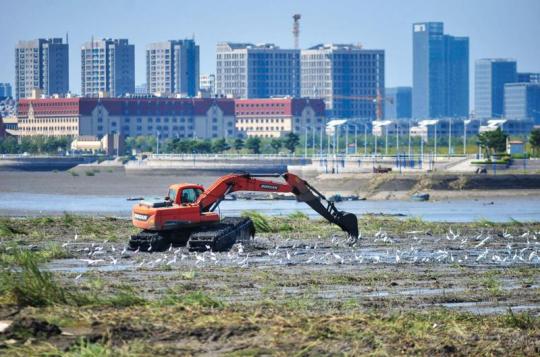
View On WordPress
0 notes
Text
Everglade Threat: From Urbanization to Pollution
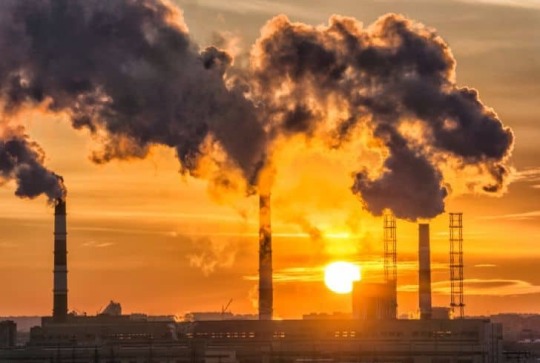
Due to human impacts, more than 50% of the Everglades have been converted for urban development and agricultural purposes [2]. A rise in Everglades conversion occurred shortly after World World II following a huge population boom in Florida. With the sudden population growth, many developers saw this as an opportunity to use the Everglades for agricultural and land development purposes. This was further supported by the belief that the Everglades was useless land and urbanization would not be harmful to this ecosystem [4]. They. were. wrong!!
Now we know how urbanization affects the everglades with land developments but what about pollution?
1. Water Flow and Pollution: anthropogenic activities (i.e. urban developments) have disrupted the natural water flow in the Everglades resulting in a high vulnerability to water pollution (accumulates and concentrates). As we briefly mentioned before, the Everglades is an ecosystem that supports over 40 species of endangered and threatened plants and animals.
The increase in human population amplifies the issue by increasing the amount of pollution being dumped into the Everglades and severely impacting its ecosystem.
2. Air Pollution: Industrialization within the surrounding urban settlements has lead to the decrease in air quality especially with the increase of ozone being found in the lower troposphere that we breathe! Tropospheric ozone is formed when sunlight causes NO2 released by vehicles to react with organic compounds in the air. The ozone and other greenhouse gases then interact with infrared energy that bounced off of the Earth leading to warmer temperatures associated to the ”greenhouse effect” and ultimately CLIMATE CHANGE!!. Another issue with tropospheric ozone is that it greatly affects ozone-sensitive plant species like the American Elder and Smooth Cordgrass [5].
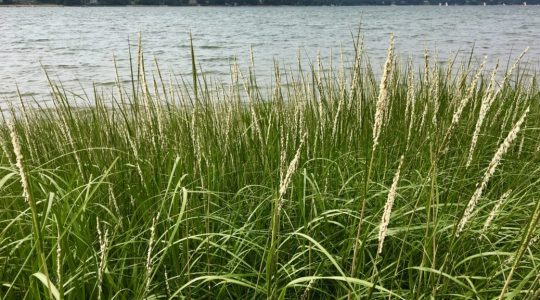
3. Nutrient Pollution:
The Everglades is extremely oligotrophic, meaning, it is an environment that does not need high concentrations of nutrients to sustain a diverse environment. This also means that any increase in nutrients can completely throw off the balance within this environment.
Lake Okeechobee is critical in the Everglades hydrologic system and one of the major stressors that characterize it is the high loading of phosphorus due to the construction of urban developments and agriculture. A Levee, which is an artificial wall that prevents water from going to a specific spot was built in Lake Okeechobee. This levee prohibited the natural flow of water from the wet season and canals were used to divert the water to the south of the lake to reduce phosphorus levels by essentially drying out the land. They wanted to use this land to reduce phosphorus production, but they also wanted to use the majority of these lands for urban developments. This was a major problem because that drained area contained rich organic soil which was then eventually used by farms for agriculture and as stated above, land development. Due to the drainage of wetlands, the natural water flow has been decreased and there has been an increase in water pollution [1]. There is a profound linkage between pollution and agriculture, so many of the destructive impacts are similar and correlate to the effects of agriculture. Agriculture is another major issue in the Everglades. To find out more about agriculture, go to this post!
This expanded area is now known as Everglades Agriculture Area (EAA). There are three different water conservation areas, but instead of using natural overland sheet flow, canals are used to carry the flow of the water. These canals have been implemented as a way to reduce high inputs of phosphorus, but they have negatively impacted the ecosystem [1]. The water depths and hydroperiods have been impacted and a lot of the native vegetation is no longer present. In addition to the overland water flow, fertilized cropland and agriculture-associated lands have led to an increase in water pollution. As a result, the Greater Everglades Ecosystem has been estimated to contain over 400,000 metric tons of phosphorus per year. The water that is being drained is essentially causing more damage than good, it is resulting in the pollution that is picked up by the runoff and into canals that are being discharged into the water conservation areas. We know that the Everglades is an oligotrophic-based environment and with an increase in these phosphorus levels, there has been an exponential growth of algae which is unfavorable because it can lead to hypoxia. Hypoxia is where there is low dissolved oxygen availability in the water, which can cause death to aquatic life and grow algal blooms that produce toxins to humans as well as aquatic animals. Not only are there severe impacts on pollution but due to the degradation of habitats from urbanization, many animals are being displaced from their natural habitats as well.
So how can we fix this problem? How do we save the Everglades?
If you want to find out, keep a lookout for my next post and navigate through the links that have been referred to throughout this post!!
To find out more about the pollution revolved around the Everglades check out this link!
-MOD Harsika

Sources:
Gregory B. Noe, Daniel L. Childers, & Ronald D. Jones. (2001). Phosphorus Biogeochemistry and the Impact of Phosphorus Enrichment: Why Is the Everglades So Unique? Ecosystems (New York), 4(7), 603–624. https://doi.org/10.1007/s10021-001-0032-1
Schade-Poole, K., & Möller, G. (2016). Impact and Mitigation of Nutrient Pollution and Overland Water Flow Change on the Florida Everglades, USA. Sustainability (Basel, Switzerland), 8(9), 940–. https://doi.org/10.3390/su8090940
Save-The-Everglades. (2021, April 06). The Florida Everglades: Impact of Agriculture. Retrieved from https://save-the-everglades.tumblr.com/post/647744654111031296/the-florida-everglades-impact-of-agriculture
Young, H. (2019, December 13). Interesting facts ABOUT watershed and Marshland conservation in Florida. Retrieved from https://www.floridaraised.com/blog/2019/12/13/interesting-facts-about-watershed-and-marshland-conservation-in-florida
Air quality. (2021). Retrieved from https://www.nps.gov/ever/learn/nature/airquality.htm
0 notes
Text
Spartina alterniflora
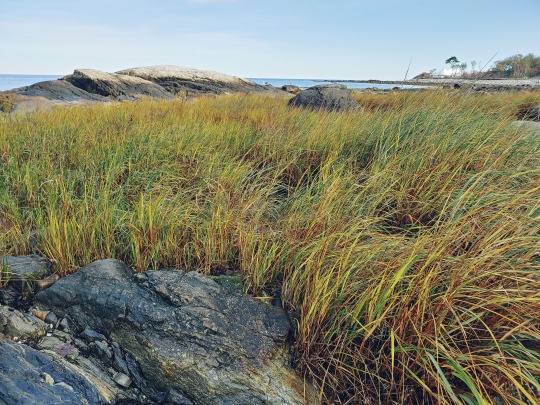
Spartina alterniflora Common Name: Smooth Cordgrass (How to remember Spartina alterniflora: A Spartan’s sword (blade) of grass and spirulina protein drink, an alternative flower (alterniflora))
What is a shoreline plant community without some grass? This appears to be Spartina alterniflora, aka smooth cordgrass, a medium height grass that I found growing in the sand and mud surrounding these tide pools.
I find it difficult to identify grasses, so I used a combination of methods: a plant ID app, a online New Hampshire-specific coastal plant guide ( “Life in New Hampshire Salt Marshes: A Quick-Reference Field Guide” (NH DES)), and features like its visible young seeds and leaf arrangement.
Smooth cordgrass comes in short (<2′) and tall (2-7′) forms, so this plant appears to be of the short variety. It’s possible that its height was influenced by the shallow soil or high salinity. Native to Atlantic coast salt marshes, smooth cordgrass thrives in shallow, saturated, saline soils. It is a pioneer plant that colonizes a broad range of substrates (sand, clay, gravel, silt) in the intertidal zone. It is a very tolerant plant, so it is useful for shoreline erosion control, forming dense stands (as seen here). It can tolerate inundation up to 12 hours a day and pH ranges from 4.5 to 8.5. However, it does prefer low to moderate wave action.
All photos were taken at Odiorne Point State Park in New Hampshire on October 18th, 2020
You can see the some seeds (below) this plant produces tiny white flowers from July to September
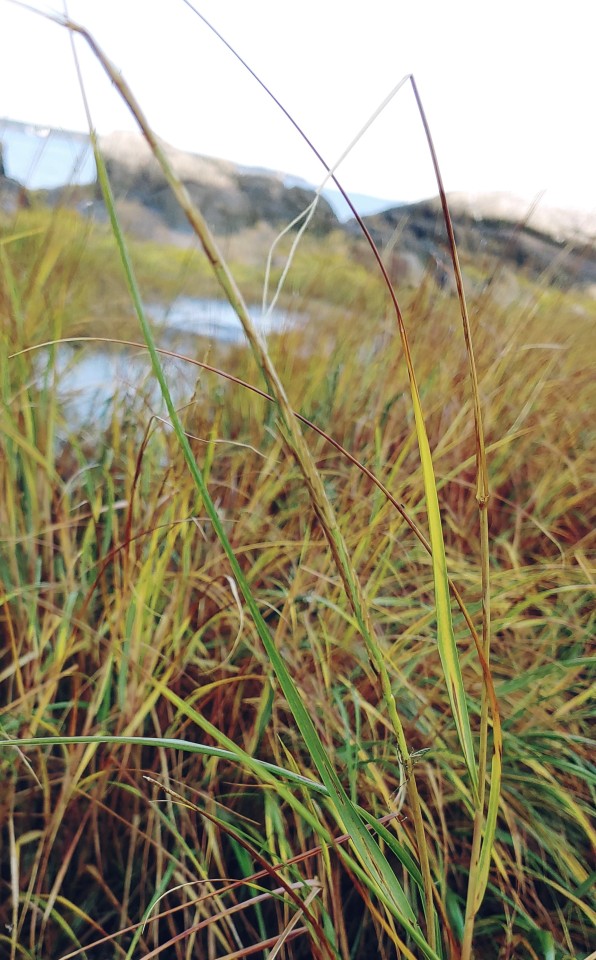
See the alternate leaf arrangement (below)
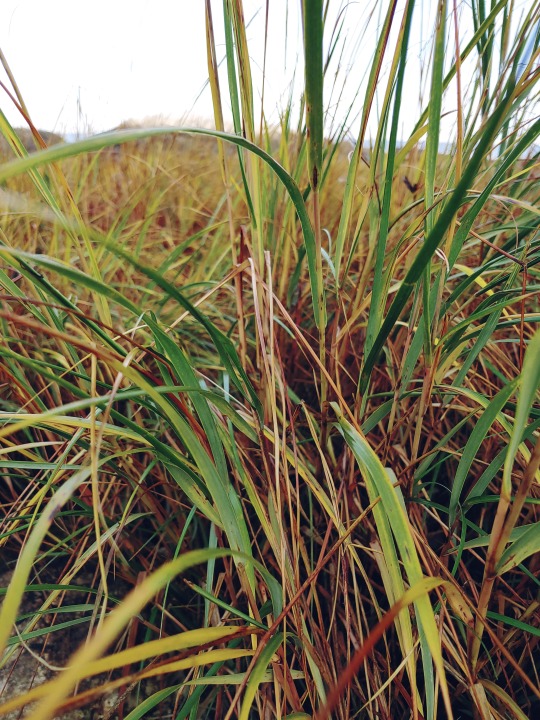
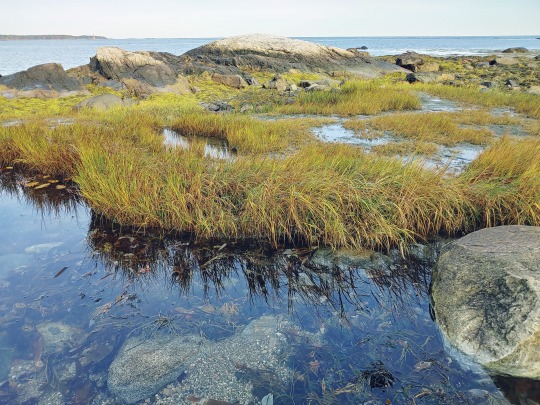

Web References:
https://www.des.nh.gov/organization/commissioner/pip/publications/wd/documents/wd-04-19.pdf (document page 20)
https://www.chesapeakebay.net/S=0/fieldguide/critter/smooth_cordgrass
https://www.fs.fed.us/database/feis/plants/graminoid/spaalt/all.html
http://issg.org/database/species/ecology.asp?si=792&fr=1&sts=&lang=EN
0 notes
Text
0 notes
Text
July 6, 2018, Roger’s Entry
At 8:15 (as soon as breakfast had finished and we had all made it to the dock) our class left for Odiorne Point under a cloudy sky. As the boat made its way inland, towards Portsmouth, we were able to feel a distinct temperature shift between the cold seas and warmer mainland.
When we arrived at Odiorne, we first examined the shore. Our instructor, Gregg Moore, was looking for the remnants of the beachside sunken forest: somewhat large, weather-worn wood masses embedded in the rocky sand. These marked the location of where a white cedar woodland once stood. We used these wooden remnants as locations at which to record elevation with the equipment that we had brought along.

Once we had gotten a feel for the equipment, we headed over to the salt marsh on the other side of the road and began recording data. At various locations, we recorded GPS co-ordinates, elevation, and the local dominant salt marsh species. Along the way we learned about salt hay, smooth cordgrass, spikegrass, and blackgrass, and began to recognize them by their physical appearance and signature colors. We also encountered a few unfortunate muddy setbacks, and so learned that stepping directly into mud flats is likely not a very good idea
After data collection (which was to help further a project of one of Gregg’s associates) we traveled to Jackson Estuarine Laboratory where we washed our boots off, ate lunch, and gathered materials for the individual mini research projects. After a car and boat ride back (and a nap on the dock white waiting for the boat), we talked about these projects more over dinner back on Appledore. A quick run to central pond for a “sipper” demonstration (needed for tomorrow’s data collection) completed the day.
0 notes
Text
What to see in annamariaisland – Natural attractions – Coquina Baywalk – Anna Maria Island
07/20/2017
Anna Maria Island has it’s own preserve. Located on Bradenton Beach directly across from the Coquina Beach at the southern tip of Anna Maria Island. This little strip of island provides beautiful views of beautiful Sarasota Bay.
Once a spoil island overgrown with non-native plants that greatly reduced its habitat value, Leffis Key is now a shining example of how government and private interests can collaborate to restore and enhance vital saltwater wetlands, essential to the health of a nationally significant estuary.
One of the unique features of the design is a 26-foot high hill in the center of the restored area. This upland feature offers a breathtaking 360 degree view of Sarasota Bay and the Gulf of Mexico. The hill was planted with native dune and coastal ridge plants such as sea oats, beach elder, dune sunflower, southern red cedar, green buttonwood, sea grape, gumbo-limbo, Hercules’ club, Jamaica dogwood and strangler fig. In addition, over 20,000 marsh grass plants, such as smooth cordgrass, saltwater cordgrass and salt jointgrass, were installed along the banks of the tidal ponds. The plant installation was accomplished with volunteer labor that included hundreds of school children, local environmental clubs and citizens.
Site amenities include footpaths that circle and scale the hill, benches, and 1,500 lineal feet of boardwalks that meander through the mangrove forest, with strategically placed viewing platforms penetrating the open water. Interpretive signs describing the various habitats and the respective plant and animal life are located along the paths.
Click here for more local information about #whattoseeannamariaisland
This post was created by Terry Whyte
This article was first published at http://bit.ly/2voOwet
#annamariaisland, #whattosee, #whattoseeannamariaisland, #vacationinannamariaisland, #holidayinannamariaisland
The post What to see in annamariaisland – Natural attractions – Coquina Baywalk – Anna Maria Island appeared first on AnnaMariaIslandCondoRentals.com.
http://bit.ly/2gOo2jn
0 notes
Photo

New Post has been published on https://vacationsoup.com/what-to-see-in-annamariaisland-natural-attractions-coquina-baywalk-anna-maria-island/
What to see in annamariaisland - Natural attractions - Coquina Baywalk - Anna Maria Island
07/20/2017
Anna Maria Island has it’s own preserve. Located on Bradenton Beach directly across from the Coquina Beach at the southern tip of Anna Maria Island. This little strip of island provides beautiful views of beautiful Sarasota Bay.
Once a spoil island overgrown with non-native plants that greatly reduced its habitat value, Leffis Key is now a shining example of how government and private interests can collaborate to restore and enhance vital saltwater wetlands, essential to the health of a nationally significant estuary.
One of the unique features of the design is a 26-foot high hill in the center of the restored area. This upland feature offers a breathtaking 360 degree view of Sarasota Bay and the Gulf of Mexico. The hill was planted with native dune and coastal ridge plants such as sea oats, beach elder, dune sunflower, southern red cedar, green buttonwood, sea grape, gumbo-limbo, Hercules’ club, Jamaica dogwood and strangler fig. In addition, over 20,000 marsh grass plants, such as smooth cordgrass, saltwater cordgrass and salt jointgrass, were installed along the banks of the tidal ponds. The plant installation was accomplished with volunteer labor that included hundreds of school children, local environmental clubs and citizens.
Site amenities include footpaths that circle and scale the hill, benches, and 1,500 lineal feet of boardwalks that meander through the mangrove forest, with strategically placed viewing platforms penetrating the open water. Interpretive signs describing the various habitats and the respective plant and animal life are located along the paths.
Click here for more local information about #whattoseeannamariaisland
This post was created by Terry Whyte
This article was first published at https://annamariaislandcondorentals.com/tag/whattosee
#annamariaisland, #whattosee, #whattoseeannamariaisland, #vacationinannamariaisland, #holidayinannamariaisland
#holidayinannamariaisland#vacationinannamariaisland#whattoseeannamariaisland#AnnaMariaIsland#whattosee
0 notes
Text
Propagation of smooth cordgrass, Spartina alterniflora, from seed in North Carolina
http://dlvr.it/PR6WX2
0 notes
Photo

Smooth Cordgrass, Spartina alterniflora (by me)
#Smooth Cordgrass#Spartina alterniflora#Spartina#Zoysieae#Chloridoideae#Poaceae#Poales#cordgrass#grass#wetlands#saltmarsh#autumn#Richard A. Rutkowski Park#Bayonne#Hudson County#New Jersey#mine
14 notes
·
View notes
Text
Seedling response to photoperiod and temperature by smooth cordgrass, Spartina alterniflora, from Oregon Inlet
http://dlvr.it/P4vVG7
0 notes